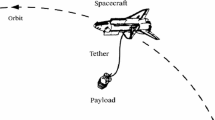Abstract
Based on the nonlinear dynamic equations of a tethered satellite system with three-dimensional attitude motion, an analytical tether length rate control law for deployment is derived from the equilibrium positions of the system and the scheme of the value range of the expected in-plane pitch angle. The proposed control law can guarantee that the tensional force acting on the end of the tether remains positive. The oscillation of the out-of-plane roll motion in conjunction with the in-plane pitch motion is effectively suppressed during deployment control. The analytical control law is still applicable, even if the system runs on a Keplerian elliptical orbit with a large eccentricity. The local stability of the non-autonomous system during deployment control is analyzed using the Floquet theory, and the global behavior is numerically verified using simple cell mapping. The numerical simulations in the paper demonstrate the proposed analytical control law.









Similar content being viewed by others
References
Gläßel H, Zimmermann F, Brückner S et al (2004) Adaptive neural control of the deployment procedure for tether-assisted re-entry. Aerosp Sci Technol 8(1):73–81
Wen H, Jin DP, Hu HY (2008) Optimal feedback control of the deployment of a tethered subsatellite subject to perturbations. Nonlinear Dyn 51(4):501–514
Wen H, Chen H, Jin DP et al (2012) Deployment and attitude control of a tethered subsatellite with controllable arm. Chin J Theor Appl Mech 44(2):408–414 (in Chinese)
Iki K, Kawamoto S, Yoshiki M (2014) Experiments and numerical simulations of an electrodynamical tether deployment from a spool-type reel using thrusters. Acta Astronaut 94(1):318–327
Mantellato R, Valmorbida A, Lorenzini EC (2015) Thrust-aided librating deployment of tape tethers. J Spacecr Rocket 52(5):1395–1406
Barkow B, Steindl A, Troger H et al (2003) Various methods of controlling the deployment of a tethered satellite. J Vib Control 9(1):187–208
Tanaka Y, Hanada T, Hirayama H (2005) Applying a simple control law to deploy space tether on a micro tethered satellite. In: The 56th international astronautical congress, Fukuoka, Japan
Williams P (2008) Deployment/retrieval optimization for flexible tethered satellite systems. Nonlinear Dyn 52(1–2):159–179
Yu BS, Jin DP (2010) Deployment and retrieval of tethered satellite system under J 2 perturbation and heating effect. Acta Astronaut 67(7–8):845–853
Yu BS, Jin DP, Pang ZJ (2014) Coupling dynamicals of spacecraft with deployment of a tether. Sci Sin E 44(8):858–864 (in Chinese)
Liu YY, Zhou J, Chen HL (2012) Variable structure control for tethered satellite fast deployment and retrieval. Future Control Autom 172(1):157–164
Steindl A (2014) Optimal control of the deployment (and retrieval) of a tethered satellite under small initial disturbances. Meccanica 49(8):1879–1885
Jung W, Mazzoleni AP, Chung J (2015) Nonlinear dynamical analysis of a three-body tethered satellite system with deploymen/retrieval. Nonlinear Dyn 82(3):1127–1144
Aslanov VS (2016) Swing principle for deployment of a tether-assisted return mission of are-entry capsule. Acta Astronaut 120(1):154–158
Hsu CS (1987) Cell-to-cell mapping: a method of global analysis for nonlinear systems. Applied mathematical sciences. Springer, NY
Acknowledgements
This study was funded by the Natural Science Foundation of China (11290153, 11672125), and in part by the Fundamental Research Funds for the Central Universities (NS2016009) and the Priority Academic Program Development of Jiangsu Higher Education Institutions.
Author information
Authors and Affiliations
Corresponding author
Ethics declarations
Conflict of interest
B. S. Yu, D. P. Jin and H. Wen have no conflicts of interest.
Rights and permissions
About this article
Cite this article
Yu, B.S., Jin, D.P. & Wen, H. An analytical control law of length rate for tethered satellite system. Meccanica 52, 2035–2046 (2017). https://doi.org/10.1007/s11012-016-0567-z
Received:
Accepted:
Published:
Issue Date:
DOI: https://doi.org/10.1007/s11012-016-0567-z




